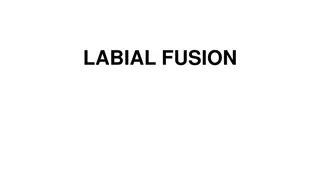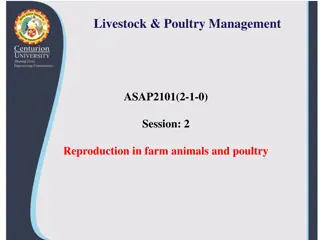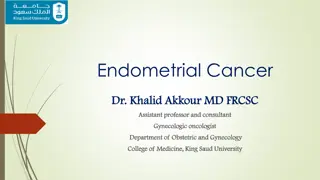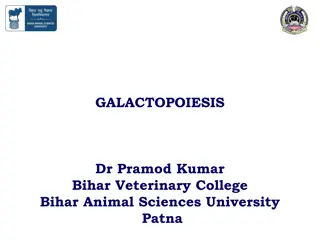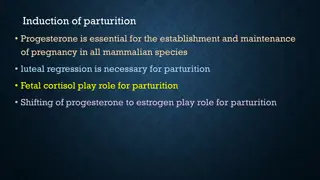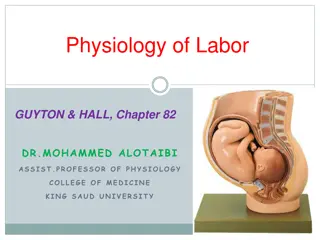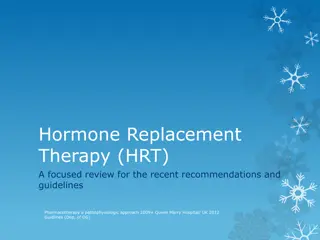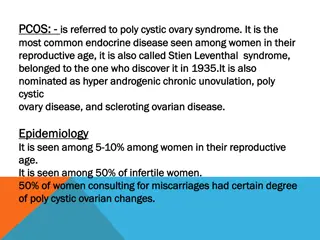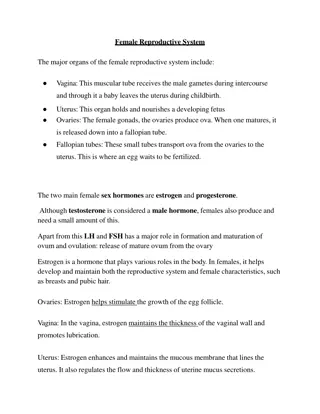Understanding Reproductive Hormones in Males and Females
Reproductive hormones play crucial roles in the body, acting as chemical signals released by endocrine cells. In males, hormones like testosterone, gonadotropin, and estrogen regulate various functions related to reproduction. Similarly, in females, hormones like GnRH, FSH, and LH are essential for
6 views • 16 slides
Understanding Heavy Menstrual Bleeding: A Comprehensive Overview
A detailed exploration of heavy menstrual bleeding (HMB) by Consultant Gynaecologist Mary Connor, highlighting its impact on women's health and well-being. The importance of early investigations, treatments, and referrals, as well as key considerations for women with obesity or estrogen imbalances.
4 views • 34 slides
Understanding Labial Fusion: Causes, Symptoms, and Treatment
Labial fusion is a medical condition where the labia minora partially or fully fuse together. It is most common in infants and young children, with suggested causes being low estrogen levels and irritative conditions. While often asymptomatic, some cases may lead to urinary issues. Treatment may inv
0 views • 10 slides
Understanding Reproduction in Livestock and Poultry Management
This course delves into the intricate processes of reproduction in farm animals and poultry, covering stages like proestrus, estrus, metestrus, diestrus, and anestrus. It explores the roles of hormones like testosterone, estrogen, progesterone, relaxin, and oxytocin in regulating reproductive functi
0 views • 51 slides
Understanding Breast Development and Changes in Females
The breast, a vital organ in the upper ventral region of the torso, undergoes significant changes during puberty, the menstrual cycle, pregnancy, and milk production. These changes are driven by hormonal fluctuations, primarily estrogen and progesterone, resulting in the growth of milk ducts, format
0 views • 68 slides
Understanding Endometrial Cancer: Risk Factors, Diagnosis, and Management
Endometrial cancer, the most common gynecological malignancy in women, presents with abnormal uterine bleeding and affects women mainly during menopause. Risk factors include hormonal stimulation and estrogen levels. Differentiating between types of endometrial cancer can impact treatment decisions.
3 views • 31 slides
Understanding Galactopoiesis and Milk Ejection in Veterinary Science
Galactopoiesis is the process of maintaining lactation in animals, involving hormones like prolactin, GH, cortisol, PTH, insulin, and oxytocin. This process also includes the role of progesterone, estrogen, and other hormones in milk production and release. Milk ejection, facilitated by oxytocin, in
0 views • 5 slides
Understanding the Menstrual Cycle: Phases and Hormonal Regulation
Menstruation is a natural process where the uterine lining sheds accompanied by bleeding in monthly cycles. The menstrual cycle consists of three phases - Follicular, Ovulatory, and Luteal - regulated by hormones like estrogen and progesterone. This cycle starts with menstruation, followed by the re
0 views • 11 slides
Pharmacology of Ovulation-Inducing Drugs
Understanding the mechanism of ovulation and hormonal regulation is key in classifying drugs used to induce ovulation. This lecture covers the pharmacology of different groups of drugs, their mechanisms of action, administration protocols, indications, efficacy rates, and adverse effects. Antiestrog
0 views • 6 slides
Understanding Hormones and Reproductive Changes in Adolescence
Changes during adolescence are driven by hormones like testosterone in boys and estrogen in girls, leading to physical developments such as facial hair growth and breast development. Hormones play a crucial role in initiating reproductive functions, with endocrine glands releasing hormones to target
0 views • 19 slides
Understanding Hormones in Implants and Their Relationship to Cancer Risk
Hormones found in implants and naturally in animals and plants can impact estrogen levels, but the connection to cancer risk is complex. This article explores the presence of hormones in food, the concept of nanograms, human estrogen production, and the implications of using implants in beef product
0 views • 33 slides
Understanding Induction of Parturition in Mammals
Induction of parturition in mammals involves the essential roles of progesterone, luteal regression, fetal cortisol, and the shift from progesterone to estrogen. This process is crucial for saving the lives of both the dam and fetus. Corticosteroids like dexamethasone and flumethasone are commonly u
0 views • 10 slides
Understanding Menstruation and Ovulation Cycle in Women
Menstruation, the cyclic uterine bleeding, is a result of hormonal interplay. It signifies ovarian events controlled by the hypothalamic-pituitary axis. The menstrual cycle, spanning from one period to the next, involves the release of ova and hormones like estrogen and progesterone. Menstruation ty
0 views • 49 slides
Understanding Puberty: A Guide for Girls
Puberty is a significant stage in a girl's life when her body undergoes various physical and emotional changes, preparing her for young adulthood. Hormones like estrogen, progesterone, and testosterone play vital roles in these transformations. Physical changes include growth spurts, body hair growt
0 views • 33 slides
Alcohol and Cancer Risk: Understanding the Links
Alcohol consumption is linked to an increased risk of various cancers, including mouth, throat, esophagus, breast, liver, and colorectal cancers. Factors such as ethanol, acetaldehyde, nutrient absorption, estrogen levels, and liver cirrhosis play a role in this risk. Even light drinking can elevate
0 views • 17 slides
Understanding the Physiology of Labor in Pregnancy
Labor, also known as parturition, is the process of uterine contractions leading to the expulsion of the fetus. Various hormonal changes, including increased estrogen levels, play a crucial role in triggering and regulating labor. The progression from a quiescent uterus to active contractions involv
0 views • 29 slides
Physiology of Labor: Onset and Key Hormonal Changes
Labor, or parturition, involves uterine contractions leading to the fetus's expulsion. Factors triggering labor include hormonal changes like increased estrogen and decreased progesterone, which stimulate uterine muscle activity. Telocytes play a role in spontaneous uterine activity, while oxytocin
0 views • 36 slides
Hormone Replacement Therapy (HRT): Recent Recommendations and Guidelines
Comprehensive overview of Hormone Replacement Therapy (HRT) focusing on indications for use, contraindications, estrogen and progestogen therapy guidelines, and combination regimens. Emphasizes the importance of HRT in treating menopausal symptoms and preventing osteoporosis, while highlighting pote
0 views • 25 slides
New Horizon for Overcoming Hormonal Treatment Resistance in Metastatic Breast Cancer Patients
Breast cancer, particularly estrogen receptor-positive tumors, poses a significant challenge due to endocrine resistance. While endocrine therapy is effective, resistance can occur in both early and advanced stages of the disease. This presentation discusses novel approaches to address this resistan
0 views • 21 slides
Understanding Polycystic Ovary Syndrome (PCOS): A Comprehensive Overview
PCOS, the most common endocrine disease in women of reproductive age, is characterized by various symptoms including abnormal metabolism of androgens and estrogen, insulin resistance, and hyperinsulinemia. This syndrome is associated with multiple theories explaining its occurrence, and its proposed
0 views • 10 slides
Overview of the Female Reproductive System and Menstrual Cycle
The female reproductive system consists of organs like the vagina, uterus, ovaries, and fallopian tubes, which play vital roles in reproduction. Hormones like estrogen and progesterone regulate various processes such as ovulation, menstruation, and pregnancy. Menstruation is part of the menstrual cy
0 views • 7 slides


